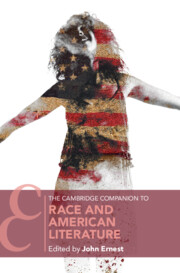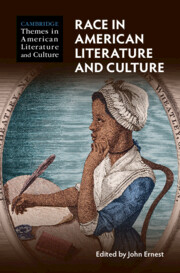72 results

The Cambridge Companion to Race and American Literature
- Coming soon
-
- Expected online publication date:
- June 2024
- Print publication:
- 27 June 2024
-
- Book
- Export citation
Efficacy of a short message service brief contact intervention (SMS-SOS) in reducing repetition of hospital-treated self-harm: randomised controlled trial
-
- Journal:
- The British Journal of Psychiatry / Volume 224 / Issue 3 / March 2024
- Published online by Cambridge University Press:
- 12 December 2023, pp. 106-113
- Print publication:
- March 2024
-
- Article
-
- You have access
- Open access
- HTML
- Export citation
Part II - Racial Citizenship
-
- Book:
- Race in American Literature and Culture
- Published online:
- 26 May 2022
- Print publication:
- 16 June 2022, pp 57-116
-
- Chapter
- Export citation
Part I - Fractured Foundations
-
- Book:
- Race in American Literature and Culture
- Published online:
- 26 May 2022
- Print publication:
- 16 June 2022, pp 9-56
-
- Chapter
- Export citation
Introduction
-
-
- Book:
- Race in American Literature and Culture
- Published online:
- 26 May 2022
- Print publication:
- 16 June 2022, pp 1-8
-
- Chapter
- Export citation
Part VII - Reflections and Prospects
-
- Book:
- Race in American Literature and Culture
- Published online:
- 26 May 2022
- Print publication:
- 16 June 2022, pp 395-436
-
- Chapter
- Export citation
Part V - Envisioning Race
-
- Book:
- Race in American Literature and Culture
- Published online:
- 26 May 2022
- Print publication:
- 16 June 2022, pp 239-306
-
- Chapter
- Export citation
Part IV - Reconfigurations
-
- Book:
- Race in American Literature and Culture
- Published online:
- 26 May 2022
- Print publication:
- 16 June 2022, pp 163-238
-
- Chapter
- Export citation
Acknowledgments
-
- Book:
- Race in American Literature and Culture
- Published online:
- 26 May 2022
- Print publication:
- 16 June 2022, pp xiv-xiv
-
- Chapter
- Export citation
Contributors
-
- Book:
- Race in American Literature and Culture
- Published online:
- 26 May 2022
- Print publication:
- 16 June 2022, pp viii-xiii
-
- Chapter
- Export citation
Contents
-
- Book:
- Race in American Literature and Culture
- Published online:
- 26 May 2022
- Print publication:
- 16 June 2022, pp v-vii
-
- Chapter
- Export citation
Part VI - Case Studies
-
- Book:
- Race in American Literature and Culture
- Published online:
- 26 May 2022
- Print publication:
- 16 June 2022, pp 307-394
-
- Chapter
- Export citation
Part III - Contending Forces
-
- Book:
- Race in American Literature and Culture
- Published online:
- 26 May 2022
- Print publication:
- 16 June 2022, pp 117-162
-
- Chapter
- Export citation
Index
-
- Book:
- Race in American Literature and Culture
- Published online:
- 26 May 2022
- Print publication:
- 16 June 2022, pp 437-452
-
- Chapter
- Export citation
Copyright page
-
- Book:
- Race in American Literature and Culture
- Published online:
- 26 May 2022
- Print publication:
- 16 June 2022, pp iv-iv
-
- Chapter
- Export citation

Race in American Literature and Culture
-
- Published online:
- 26 May 2022
- Print publication:
- 16 June 2022
Chapter 5 - Nineteenth-Century Autobiographical Writings by Freeborn African Americans
- from Part I - Origins and Histories
-
-
- Book:
- A History of African American Autobiography
- Published online:
- 30 September 2021
- Print publication:
- 22 July 2021, pp 69-84
-
- Chapter
- Export citation
Growth of Monolayer MoS2 on Hydrophobic Substrates as a Novel and Feasible Method to Prevent the Ambient Degradation of Monolayer MoS2
-
- Journal:
- MRS Advances / Volume 5 / Issue 52-53 / 2020
- Published online by Cambridge University Press:
- 02 July 2020, pp. 2707-2715
- Print publication:
- 2020
-
- Article
- Export citation
Frontmatter
-
- Book:
- ALT 36: Queer Theory in Filmand Fiction
- Published by:
- Boydell & Brewer
- Published online:
- 25 March 2020
- Print publication:
- 16 November 2018, pp i-vi
-
- Chapter
- Export citation
TRIBUTE
-
- Book:
- ALT 36: Queer Theory in Filmand Fiction
- Published by:
- Boydell & Brewer
- Published online:
- 25 March 2020
- Print publication:
- 16 November 2018, pp -
-
- Chapter
- Export citation



